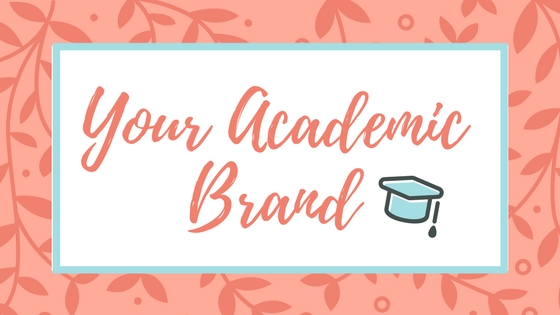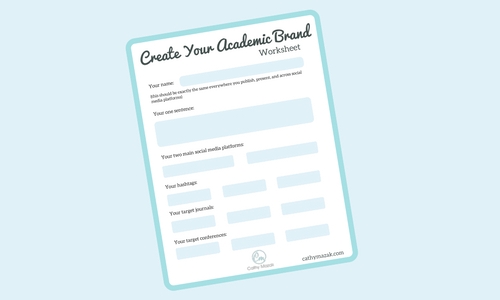Obviously the world of academia today (and the world in general) is qualitatively different than it was twenty years ago. Twenty years ago academics became familiar with the work of other academics through publications (actual paper books in libraries and journals that were, again, actually printed on paper and arrived in, err, the mail. Remember mail?), in-person conferences and lectures, and, well, that’s it.
Today if someone wants to find information about you or a particular research area there a ton of ways to do so: Google, Google scholar, LinkedIn, Academia.edu, Twitter, Facebook, Amazon, JStor…the list goes on and on. And even if you aren’t on social media (though I bet you are), something will come up about you (or someone with your name) on Google.
This is all to say that you already have an academic brand, whether you buy into the business terminology or no. There is an image of you out there in the world, partially constructed by you and partially constructed for you by your institutional affiliations, your publications, and the pictures of your cat on Instagram. 🙂 And this image, now more than ever, if extremely accessible not only to your academic colleagues and students, but to millions of other people. From their phones.
For this reason alone you should begin to think about developing your academic brand, but there are even more compelling reasons. If you have a well-defined academic brand, you can make decisions about what you want to do with your career that builds that brand. You are more likely to say no to spurious projects, more focused in your pursuit of brand-building activities. By actively crafting your academic brand, you begin to control the image you are putting out in the world, particularly online. The result is that people who are looking for you find you, not someone else’s dribs and drabs about you.
What is an academic brand?
The term academic brand is a profession-specific version of the term personal brand. Your personal brand is the image of yourself that you present the the world. Borrowed from the world of marketing (which is why it makes some academics bristle), it includes who you are, what you do, and how you represent what you do to the world. (It is your habitus, in Bourdieu’s terms.) Academic brand just means the personal brand that you construct for yourself as an academic. Your academic brand is not exactly your identity/ies, but rather the professional identity that you purposefully craft and show to the world.
I’m not suggesting that your brand is disingenuous. But I am saying that your brand is yours to construct. You don’t have to make your political beliefs part of your brand, for example, if you don’t want to. Some fields will accept the inclusion of political beliefs in your academic brand more than others. There are no hard-and-fast rules. You need to decide what you include and what you leave out as you go through the process of constructing your personal brand.
You may want to intentionally separate your academic brand from your personal brand. As an example, I have a pretty well-developed personal brand on social media that could be explained as: working fit mom who doesn’t take herself, or this crazy parenting thing, too seriously. My academic brand is more focused on post-structural linguistic practices in higher education classrooms. Both brands are evolving, and I hope, merging into something more like: leading post-structural linguistic researcher mom of three who is trying to balance academia, parenting, and her own well-being with love and self-forgiveness.
For me, I am striving to merge my academic and personal brands, but you may not feel comfortable or ready to do that–and that’s perfectly fine. The important thing is to begin crafting your brand (personal or academic) so that you are in control. The process of doing so not only helps create a better representation of you in to the world, but also can be an excellent tool for developing your own focus as you navigate the sticky waters of tenure, family, publications, teaching, service…what I call this academic life.
Finding your academic brand
Let’s start by defining your academic brand, and then we’ll move on to how to put it out there.
I’ve created a worksheet to go along with this post. It is meant for you to download, print out, fill out, and then hang on your office wall. You can get it here:
Name consistency
The first thing to decide upon is your name. It may seem simple to some, but of course it’s not. Intentionally or not, there are probably various versions of your name out there. If you haven’t already, it’s time to make a decision about exactly how you want your name to appear and to be consistent and diligent in making sure that it appears that way in publications, conference programs, and social media.
For example, my fields of study are overlapping, but to simplify for now let’s say education and linguistics. APA is the most common format in these fields, and APA uses the author’s middle initial, so early on I decided that I wanted my academic name to be “Catherine M. Mazak” so that my middle initial will get used (in APA-formatted reference lists I’ll be C.M. Mazak).
My husband is an animal scientist and he is Puerto Rican. It is very important to him that both his last names are used in publication. For that reason, he decided to hyphenate his last names (Ortiz-Colón) so that he would not be accidentally cited as “Colón.” Many Spanish-speakers use both their paternal and maternal last names. If one is going to be dropped, it’s the maternal, or second, last name. But people not aware of this tradition may make the paternal last name into the middle name and the maternal last name as the last name, leaving my poor husband with the name Guillermo O. Colón, which is not him at all–and a search for that name would not turn up his institutional affiliation, for example.
Some scholars may also want to use an initial rather than a first name, or change their name when they get married or divorced. All these things need to be taken into consideration when choosing the way you want to represent your name. Here’s a quick list of considerations when deciding on your name:
- How your name already appears in your most read publication
- How your field’s citation system will represent your name
- How your name will change (or not) with your legal status (marriage, divorce)
- How you can best represent your name if it does not fit into the privileged North American naming system
There are tools that can help you standardize your name across research platforms, such as ORCID. In ORCID you can basically hook different versions of your name (as they appear in different publications and online systems) together, essentially telling the internet “these are all me” (and the inverse–these are not me). This is worth taking the time to do.
Your one sentence
In addition to your name, you should take the time to create what I call your ONE SENTENCE (it’s in all caps because your supposed to read it in Darth Vader’s voice). Your ONE SENTENCE is your academic mission statement. It’s like your elevator pitch, but just one sentence. I’ve written all about how to write it (including giving you a formula) here, so go check it out.
Articulating your academic mission concisely and in writing will go a long way to helping you develop clarity and focus. Write it down, print it out, and hang it in your office! All your decisions should be motivated by this ONE SENTENCE.
Communicating your academic brand in the world
You have two basic mediums for communicating your brand to the world: in person and online. Since you probably have the most questions about your online presence, let’s start there.
Social media
There are many social media outlets out there, and of course the number is growing every day. Some of these platforms are for everyone (Facebook, Twitter, Instagram), and some are for academics or professionals specifically (Academia.edu, LinkedIn, ResearchGate). It can be overwhelming and super confusing, and, let’s face it, a major time suck. We certainly don’t have time for that.
So here’s my advice for building your academic brand through social media so it doesn’t take over your life and drive you crazy.
- Don’t try to be everywhere. Choose one general platform and one academic-specific platform and develop your profiles there. Which ones you choose are totally up to you, but look towards your field and the audience you want to impact for guidance. For example, Twitter is popular among academics. Try searching for hashtags related to your field and see what you find. Find the big-name academics or labs in your field and follow them. Use those hashtags and tag those people or labs in your posts to join (and influence) the conversation. (Go fill out your worksheet with the top three hashtags now!)
- Use the same profile pic across platforms. Just as you should use the same name across platforms as you build your brand, it also helps to use the same profile picture. And do use an actual picture of you. No one wants to have a conversation with a logo, or a picture of your cat. Take a nice, professional picture that reflects who you are.
- Create a home base. I truly believe that every professor should have a website. And I don’t mean the website that comes with your university position. I mean [yourname].com. Why? Social media platforms come and go (and so do university positions), but your website is forever. You can use your social media platforms to point back to your website, which can be as simple as an interactive CV with links to your publications, or as developed as a blog. The idea is that if LinkedIn disappears tomorrow, you don’t have to start from scratch. There are lots of free ways to create a website, including wordpress.com, but I would recommend buying your domain name and using SquareSpace or paying a little money to have someone build a little site for you. If you are on the job market (or will be), this is a particularly important tool.
Presentations, publications, and networking
The old school, but still really important, way to build your academic brand is through conference presentations, publications, and good old fashioned networking. Think of social media as the non-peer-reviewed brand and presentations and publications as the peer-reviewed brand. Both get your message out, but one without the other is just less effective.
I’m a big fan of small, niched conferences and journals, especially when you’re just starting out. When you are trying to influence a particular field (or intersection of fields), I think you should begin by talking to your people. You are much more likely to find the people who will get really excited about your ideas at conferences that are very niched.
As an example, in 2012 I was able to travel to a conference in Denmark called CALPIU, Cultural and Linguistic Practices at the International University. It pressed all my buttons: Practices! Language! Higher ed! International! At that very small conference I was able to network with people, live and in person, that resulted in: a chapter in an edited volume for me, them writing a chapter in a volume I edited, a journal publication, a book review, and some of the new people I met traveling to a conference in Puerto Rico to meet up with my research team. Not only that, by networking with folks at that conference our work influenced each other’s, and took turns that it probably wouldn’t have taken otherwise. Win-win-win! That’s less likely to happen (though still possible) at huge conferences attended by tens of thousands of people.
The same is true with niched journals. In some ways, publishing in niched journals is like preaching to the choir. But it is excellent preparation for refining your message for large, more top-tier-journal audiences. Plus, you build a name with those people who are most likely to cite you because they are doing work on topics similar to yours. (Now hop on over to the worksheet and write down three target journals and three target conferences that are small and specific to your niche.)
Good old-fashioned networking is also a great way to get your brand out there. If you see a big-name academic in your field speak, or you read one of their articles, write to that person thanking them for their work and telling them what you do. Put yourself out there in a respectful, non-demanding way. You may never get a response, but you might. It may lead to research collaborations or at least getting your work in front of audiences of interest.
I hope that this article (and the worksheet!) have given you a kick-start to developing your academic brand. For more conversations on academic life, publishing, and balance, join my Facebook group: I Should Be Writing! Still have questions about academic branding? Ask me in the comments!
Don’t forget to pick up your worksheet:







